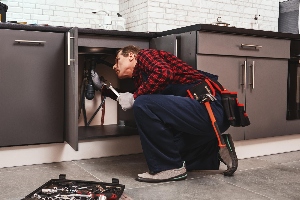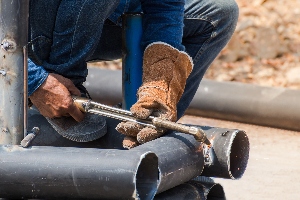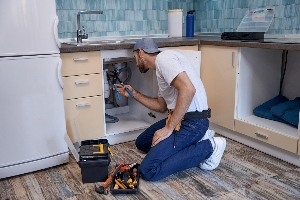Water problems in basements and around homes require the right drainage solution to prevent damage and flooding. Two of the most popular options homeowners consider are sump pumps and French drains, but choosing between them depends on your specific water issues and property needs.
The key difference is that sump pumps actively remove water that has already collected in a basement pit, while French drains passively redirect water away from your foundation before it becomes a problem. Understanding how each system works and when to use them will help you make the best decision for protecting your home.
We'll explore the purpose of each drainage method, examine the specific situations where one outperforms the other, and compare their costs and maintenance requirements.
Let’s break down the key points you should consider:
- Understanding the purpose of each system
- When should you install a sump pump?
- When is a french drain the better choice?
- Comparing cost, maintenance, and effectiveness
- Choosing the right drainage solution for your home
By the end of this article, you'll have the knowledge needed to choose the right solution for keeping your home dry and safe from water damage.
Understanding the purpose of each system
Sump pumps and French drains serve different roles in protecting your home from water damage. Sump pumps remove water that has already collected, while French drains prevent water from reaching problem areas in the first place.
What a sump pump does and where it's installed
A sump pump sits in a pit called a sump basin. This basin collects water from around your home's foundation. The pump turns on automatically when water levels rise.
We typically install sump pumps in basements or crawl spaces. The system works best in areas where the water table is high. When groundwater pressure builds up, water flows into the sump pit through drains or natural seepage.
The most common type is a submersible pump. This pump sits underwater in the pit. It pushes water up through piping and away from your home.
Sump pumps handle water that has already entered your drainage system. They're your last line of defense against flooding. The pump only runs when water actually reaches the pit.
How a french drain redirects water away
A French drain is a trench filled with gravel and a perforated pipe. Water flows into the gravel and enters the pipe through small holes. The pipe then carries water away from your home.
We install French drains around foundations or in problem areas of your yard. The system works by gravity. Water naturally flows downhill through the piping to a safe drainage area.
The gravel acts as a filter. It keeps soil from clogging the pipe holes. The drain prevents water from building up near your foundation in the first place.
French drains work continuously. They don't need electricity or moving parts. As long as water can flow downhill, the system keeps working.
The difference between sump pump vs french drain systems
The main difference is timing. French drains prevent water problems before they start. Sump pumps fix problems after water has already collected.
Sump pumps need electricity to work. They have moving parts that can break down. French drains use gravity and need no power source.
We use sump pumps when water is already entering your basement or crawl space. French drains work better for preventing water from reaching these areas. Many homes benefit from using both systems together.
Cost differences matter too. Sump pumps cost more upfront but cover smaller areas. French drains cost less per foot but may need longer installations.
When should you install a sump pump?
We recommend sump pumps for homes with consistently high water tables and basements prone to flooding. These systems work best when water needs to be lifted out of below-grade areas where gravity drainage isn't possible.
Best use cases for homes with high water tables
High water tables create constant pressure against your foundation walls. When groundwater sits close to the surface, it can seep through foundation cracks and overwhelm other drainage methods.
Key situations where sump pumps excel:
- Basements below the water table level
- Areas with clay soil that doesn't drain well
- Homes in flood-prone valleys or near water sources
- Properties where French drains can't reach proper discharge points
We install sump pumps in a sump pit dug at the lowest point of your basement floor. The pit collects water that would otherwise pool on your basement floor.
Spring snowmelt and heavy rains often raise water tables temporarily. A sump pump handles these seasonal changes better than passive drainage systems.
How a sump pump handles basement flooding
Sump pumps actively remove water from your basement through mechanical pumping action. The system turns on automatically when water reaches a certain level in the sump pit.
The pumping process works like this:
- Water enters the sump pit through drains or foundation cracks
- A float switch activates the pump when water rises
- The pump lifts water through pipes to outside discharge areas
- The system shuts off when water levels drop
Most systems can pump 2,000 to 5,000 gallons per hour. This makes them effective for basement waterproofing during heavy storms or rapid snowmelt.
We recommend installing a backup battery system for power outages. Flooding often happens during storms that knock out electricity.
Downsides to relying solely on a sump pump
Sump pumps require electricity to function, making them vulnerable during power outages. Electrical failure during storms can leave your basement unprotected when you need it most.
Common problems with sump pump systems:
- Mechanical parts can break or wear out
- Discharge pipes can freeze in winter
- Float switches sometimes stick or malfunction
- Pumps can't handle debris or thick mud
Regular maintenance keeps the system working properly. We check the pump, clean the pit, and test the float switch every few months.
Sump pumps also create ongoing costs through electricity use and part replacements. The average system runs for 10-15 years before needing replacement.
When is a french drain the better choice?
French drains work best when you need to redirect surface water away from your home's foundation or solve yard drainage problems. The system requires regular maintenance and performs differently based on your soil type and local conditions.
Ideal conditions for exterior drainage systems
French drains excel at managing surface water that pools around your property. We recommend this system when water collects in your yard after heavy rain or snow melts.
The gravel trench design works well on sloped properties. Water naturally flows downhill through the drain pipe to a safe discharge area. According to Landcare stone installation standards, a French drain must be dug 18 to 24 inches deep and laid with a slope of 0.5% to 1% (about ½ to 1 inch per 10 feet) to ensure proper gravity flow and prevent water stagnation.
French drains solve these common problems:
- Standing water in landscaped areas
- Water flowing toward your foundation
- Soggy patches in your lawn
- Yard drainage issues along driveways or walkways
A perimeter drain around your home's exterior prevents water from reaching the foundation walls. This approach stops problems before they start.
Soil type affects how well French drains work. Sandy soils drain faster than clay soils. Heavy clay may require additional drainage solutions.
Disadvantages of a french drain to consider
French drains can clog over time when sediment builds up in the gravel or drain pipe. Tree roots may grow into the system and block water flow.
The system only works with gravity flow. You cannot install French drains in areas without proper slope for water movement.
Maintenance becomes difficult once the system is buried. We cannot easily access the drain pipe for cleaning or repairs.
French drains may not handle large volumes of water during severe storms. The system works slowly compared to mechanical pumps.
Installation requires digging trenches across your property. This process can damage existing landscaping, sprinkler systems, or underground utilities.
Freezing temperatures can reduce drainage effectiveness in northern climates. Ice may block the drain pipe during winter months.
Maintenance and lifespan of french drain systems
French drains typically last 10 to 15 years with proper care. The gravel trench may need cleaning every 3 to 5 years.
Maintenance tasks include:
- Inspecting drain outlets for blockages
- Removing leaves and debris from surface grates
- Checking for settling or erosion along the trench
- Flushing the drain pipe annually
Signs your French drain needs attention include standing water above the trench or slow drainage after storms. We recommend professional inspection if these problems occur.
Fabric filters help prevent soil from clogging the gravel. Replace damaged fabric during maintenance visits.
The drain pipe may develop cracks or separations over time. Professional repair requires excavating portions of the system.
Comparing cost, maintenance, and effectiveness
When choosing between drainage systems, we need to consider upfront costs, ongoing maintenance requirements, and long-term effectiveness. Both options offer different advantages depending on your specific situation and budget.
Which is better: Sump pump or french drain for your property
Sump pumps handle higher water volumes but require electricity to operate. They work best in areas with frequent flooding or heavy water issues. We recommend sump pumps for basements that experience regular water accumulation.
French drains work continuously without power. They redirect water away from your foundation using gravity. This makes them ideal for properties with consistent but moderate water problems.
Effectiveness depends on your water issue:
- Heavy flooding: Sump pumps remove large amounts quickly
- Steady seepage: French drains provide constant protection
- Power outages: French drains keep working, sump pumps stop
Sump pumps typically last 7-10 years with proper maintenance. FEMA advises homeowners to check their sump pump yearly and replace the unit after 10 years, especially if it fails during storms or cycles on and off irregularly.
French drains can function for 20+ years if installed correctly.
The best choice depends on your water volume, power reliability, and foundation type.
What's more affordable long term
Installation costs vary significantly based on your home's size and water problems. Sump pumps cost $1,200-$3,000 installed. French drains range from $3,000-$8,000 depending on length and complexity.
Maintenance costs differ greatly:
- Sump pumps need annual inspections and part replacements
- French drains require occasional cleaning but minimal upkeep
- Repair costs average $300-$800 for sump pumps
- French drain repairs typically cost $1,000-$2,500
Long-term expenses favor French drains in most cases. While they cost more upfront, their longevity and low maintenance make them cheaper over 20 years.
Sump pumps use electricity continuously during wet periods. This adds $50-$200 to annual energy bills.
French drains have no operating costs after installation.
Combining both for maximum protection
Using both systems together provides the most reliable water protection. French drains handle everyday water issues while sump pumps manage heavy flooding events.
This combination works especially well in areas with unpredictable weather patterns. The French drain reduces how often your sump pump runs, extending its lifespan.
Installation timing matters. We recommend installing the French drain first, then adding a sump pump if needed. This approach costs $4,000-$10,000 total but offers superior protection.
Maintenance becomes more complex with both systems. You'll need to service the sump pump annually and inspect the French drain every few years.
The combined approach makes sense for homes with:
- Severe water problems
- Finished basements worth protecting
- History of flooding damage
Choosing the right drainage solution for your home
Your home's location, soil type, and local weather patterns determine which drainage system works best. Professional evaluation helps identify the most effective solution for your specific situation.
How soil, foundation, and weather play a role
Soil drainage directly affects how water moves around your foundation. Clay soil holds water and creates more pressure against basement walls. Sandy soil drains quickly but may not need extensive drainage systems.
Your foundation type matters too. Concrete block foundations often need interior drainage systems. Poured concrete foundations may work better with exterior solutions.
Weather patterns in your area shape drainage needs. Areas with heavy spring rains need systems that handle large water volumes quickly. Regions with steady rainfall throughout the year benefit from continuous drainage.
Foundation age also plays a role. Older foundations may have settling issues that affect drainage. Newer foundations often have better waterproofing but still need proper drainage design.
The slope of your property determines water flow patterns. Homes on hills may need French drains to redirect water. Homes in low areas often require sump pumps to remove standing water.
What Local Greenville & Spartanburg homeowners typically need
Greenville and Spartanburg areas receive about 45-50 inches of rain per year. The red clay soil common in these regions drains slowly and creates water pressure against foundations.
Most homes in these areas benefit from combination systems. French drains handle exterior water management. Sump pumps remove water that enters basements during heavy storms.
Local regulations in both cities require proper drainage for new construction. Many older homes need drainage upgrades to meet current standards.
Spring storms bring heavy rainfall in short periods. This creates the need for systems that handle both steady drainage and sudden water volume increases.
The rolling terrain in the Greenville and Spartanburg areas means water flows toward lower properties. Homes at the bottom of slopes often need more extensive drainage systems.
When to consult a professional for evaluation
Home inspection should include drainage assessment before major waterproofing decisions. A waterproofing contractor can identify problems that homeowners might miss.
Site evaluation reveals hidden drainage issues. Professionals use specialized tools to measure water flow patterns and soil conditions.
Call a professional when you notice water stains, musty odors, or foundation cracks. These signs often indicate drainage problems that need expert assessment.
Complex drainage situations require professional design. Homes with multiple water sources or unusual foundation layouts need custom solutions.
Waterproofing contractors understand local building codes and soil conditions. They can recommend systems that work best for your specific location and home type.
Professional evaluation costs less than fixing water damage later. Most contractors offer free initial assessments to determine your drainage needs.
Conclusion
We've covered the key differences between sump pumps and French drains to help you make the right choice. Each system works best in different situations.
Your home's specific needs will determine which system works best. Consider your budget, the type of water problem, and how much maintenance you want to do.
Some homes need both systems working together. A French drain can move water away from your foundation while a sump pump handles basement flooding.
We recommend getting quotes from local contractors for both options. They can look at your property and tell you which system fits your needs best.
The right drainage system protects your home from water damage. Take time to research your options before making a decision.
Remember that proper installation matters more than which system you choose. Both sump pumps and French drains work well when installed correctly by professionals.
Schedule a professional drainage assessment today to find out whether a sump pump, French drain, or both are right for your home.












